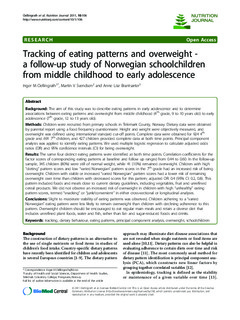| dc.description.abstract | Background The aim of this study was to describe eating patterns in early adolescence and to determine associations between eating patterns and overweight from middle childhood (4th grade, 9 to 10 years old) to early adolescence (7th grade, 12 to 13 years old). Methods Children were recruited from primary schools in Telemark County, Norway. Dietary data were obtained by parental report using a food frequency questionnaire. Height and weight were objectively measured, and overweight was defined using international standard cut-off points. Complete data were obtained for 924 4th grade and 691 7th children, and 427 children provided complete data at both time points. Principal component analysis was applied to identify eating patterns. We used multiple logistic regression to calculate adjusted odds ratios (OR) and 95% confidence intervals (CI) for being overweight. Results The same four distinct eating patterns were identified at both time points. Correlation coefficients for the factor scores of corresponding eating patterns at baseline and follow up ranged from 0.44 to 0.60. In the follow-up sample, 345 children (80%) were still of normal weight, while 41 (10%) remained overweight. Children with high "dieting" pattern scores and low "varied Norwegian" pattern scores in the 7th grade had an increased risk of being overweight. Children with stable or increased "varied Norwegian" pattern scores had a lower risk of remaining overweight over time than children with decreased scores for this pattern; adjusted OR: 0.4 (95% CI: 0.2, 0.8). This pattern included foods and meals close to current dietary guidelines, including vegetables, fruit and unrefined cereal products. We did not observe an increased risk of overweight in children with high "unhealthy" eating pattern scores, termed "snacking" or "junk/convenient" in either cross-sectional or longitudinal analyses. Conclusions Slight to moderate stability of eating patterns was observed. Children adhering to a "varied Norwegian" eating pattern were less likely to remain overweight than children with declining adherence to this pattern. Overweight children should be encouraged to eat regular main meals and retain a diverse diet that includes unrefined plant foods, water and fish, rather than fat- and sugar-reduced foods and drinks. | |
